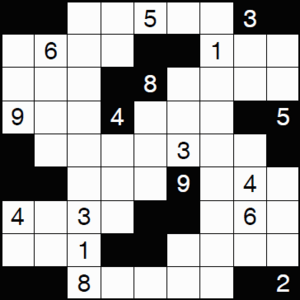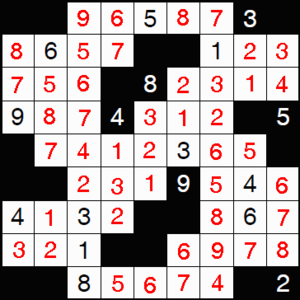Str8ts facts for kids
Str8ts is a fun logic puzzle that uses numbers. It was created by Jeff Widderich in 2008. While it's a bit like Sudoku, Str8ts has its own special rules. The name "Str8ts" comes from the word "straight" in poker. You can find this puzzle in newspapers, books, and even on apps. It even appeared on the Canadian TV show Dragons' Den in 2010!
Contents
How to Play Str8ts
In Str8ts, you get a grid, usually 9x9 squares. Some parts of the grid are divided by black squares, creating "compartments." Your main goal is to fill the white squares with numbers.
What are Straights?
Each compartment, whether it's going across or down, must contain a "straight." A straight means a set of numbers that are in order, like 4, 5, 6, 7. But here's the cool part: they don't have to be in exact order! For example, 7, 6, 4, 5 is a valid straight because it uses the numbers 4, 5, 6, and 7. However, 1, 3, 8, 7 would not be a straight because the numbers are not consecutive.
Rules for Filling the Grid
Just like in Sudoku, you need to fill the white squares with numbers from 1 to 9. Each row and each column must have unique numbers. This means you can't repeat a number in the same row or column.
Unlike Sudoku, which uses 3x3 boxes, Str8ts uses the black squares to divide rows and columns. These black squares sometimes have numbers in them. These numbers are clues! They tell you that the digit in the black square cannot be used in that specific row or column. These clue numbers are not part of any straight.
Different Kinds of Str8ts Puzzles
There are a few different versions of the basic Str8ts game. Some popular ones include Symmetric Str8ts, Asymmetric Str8ts, Mini-Str8ts, and Transformations. Each version adds a slightly different twist to the game!
How Str8ts Puzzles are Graded
Str8ts puzzles can be easy or very challenging. The difficulty, or "grade," of a puzzle depends on how many ways you can solve it at each step. It also depends on how tricky the solving strategies are.
An easier puzzle will have many spots where you can easily figure out a number. Or, you might easily rule out certain numbers. When puzzle makers look at the whole puzzle this way, they can give it a score. By looking at thousands of puzzles, they can group them into different difficulty levels, like easy, medium, hard, and expert.



